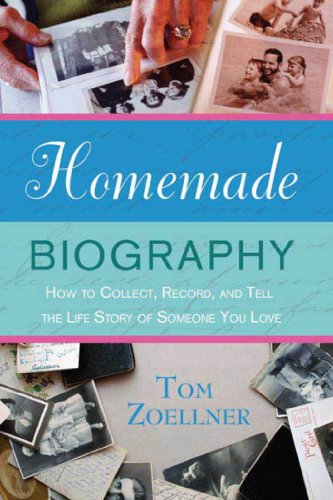How to Collect, Record and Preserve Oral History
How well do you really know the older people in your family? And how will you make sure their stories will be preserved for generations to come ? Homemade Biography (St. Martin’s Press) is a practical guide to recording a relative’s story so it will never be forgotten.
Most of us think about bringing a tape recorder or a notebook to a visit with an older relative, but few actually do it. This clear-eyed manual gives you all the expertise you’ll need to finish what could be one of the most fulfilling conversations you’ll ever have.
Praise for Homemade Biography:
“Homemade Biography by Tom Zoellner is a lovely book through and through… It includes advice on coaxing your subject to open up and dealing with potential difficulties such as Alzheimer’s disease, painful war memories or family secrets, as well as writing and publishing help. Even if you aren’t planning to write a relative’s life story, Homemade Biography gives insight into communicating with seniors. Actually, it’s a pretty great guide to being a better listener and conversationalist with anyone.”
—Austin American-Statesman
This project drew on several excellent books published previously, including
The Voice of the Past: Oral History by Paul Thompson, 3
rd Edition (Oxford: Oxford University Press, 1978);
Like It Was: A Complete Guide to Writing Oral History by Cynthia Stokes Brown (New York: Teachers & Writers Collaborative, 1988),
and Interviews That Work: A Practical Guide for Journalists by Shirley Biagi, 2
nd Edition (Belmont, Calif.: Wadsworth Publishing Company, 1992). Some questions were drawn from and inspired by these works. The account of Mildred Baker’s ball comes from “A Ball Lost for 78 Years is ’91 Christmas Present,” published in
The Smith County Pioneer, January 2, 1992, and from the radio segment “Woman Recovers Toy Ball After 78 Years,” hosted by Scott Simon on National Public Radio on January 11, 1992. Kristin Gilger’s story of her family was published by the
Salem Statesman Journal and reprinted in the 1998 special section “Under the Influence.” Lori Hope Lefkovitz’s insightful essay “Inherited Holocaust Memory and the Ethics of Ventriloquism,” was published in the winter 1997 edition of the
Kenyon Review. Excellent advice on nonfiction can be found in
The Art and Craft of Feature Writing, by William Blundell (New York: Plume, 1986). Some conversational styles are examined in
Interviews that Work: A Practical Guide for Journalists, by Shirley Biagi (Belmont, Calif.: Wadsworth Publishing Company, 1992). Forms of biographical storytelling are discussed in
How to Write Your Own Life Story, by Lois Daniel (Chicago: Chicago Review Press, 1997). Genealogical technique is explained in
Secrets of Tracing Your Ancestors, by W. Daniel Qullien (Cold Spring Harbor, N.Y.: Cold Spring Press, 2003). Tips on video production were drawn from the informative CD
Producer’s Guide by Steve Pender, (Tucson, Ariz.: Family Legacy Video, 2003). Studs Terkel’s quote about the ceiling of Grand Central Station comes from the magazine article “Hear Here,” (
Smithsonian, June 2004). The Henry Miller quote originally appeared in
Saturday Review, May 5, 1956 in an article by Rachel Girson. It has been republished in
Conversations with Henry Miller, edited by Frank L. Kersnowski and Alice Hughes (Jackson, Miss.: University Press of Mississippi, 1994) and on a tribute website maintained by William Ashley. Ernest Hemingway’s recollections of his time at the
Kansas City Star can be found on the paper’s
website, as well as
literarytraveler.com. Alain De Botton’s thoughts were drawn from
Status Anxiety (New York: Pantheon, 2004). The Sandor Ferenczi quote about children comes from his
Sex and Psychoanalysis (New York: Basic Books, 1950).
Coming Soon.





